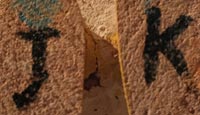Hopi Palhikmana Katsina Doll by Jimmy Kewanwytewa [SOLD]
+ Add to my watchlist Forward to Friend
- Category: Traditional
- Origin: Hopi Pueblo, Hopituh Shi-nu-mu
- Medium: wood, paint, feathers
- Size: 10” high doll;
Tablita: 14-½” high to top x 8-¼” tablita width - Item # C4726G SOLD
 This all-wood carving of the Hopi Palhikmana Katsina presents this personage in the most traditional manner—standing firmly on both feet and as a very distinguished person in an apparent motionless stance. The tablita is an extraordinary display of symbols of rain, lightning, and mountains. She wears a traditional pueblo manta, worn over the left shoulder and under the right arm. Her feet are bare for the purpose of making contact with Mother Earth. The doll is signed J K on the bottom of the feet.
This all-wood carving of the Hopi Palhikmana Katsina presents this personage in the most traditional manner—standing firmly on both feet and as a very distinguished person in an apparent motionless stance. The tablita is an extraordinary display of symbols of rain, lightning, and mountains. She wears a traditional pueblo manta, worn over the left shoulder and under the right arm. Her feet are bare for the purpose of making contact with Mother Earth. The doll is signed J K on the bottom of the feet.
Alph Secakuku, Hopi author, describes the function of Palhikmana in his book Following the Sun and Moon—Hopi Kachina Tradition as follows:
"Palhikmana is a katsina maiden with several functions. She can appear during Angak'wa as a Polimana (Butterfly maiden) or as a Corn-Grinding maiden, or she can perform a special dance.
"During the Ösömuya, a season encompassing the month of March, a series of katsina night dances take place in each of the villages. From now until July the katsina rituals and beliefs will be manifested in the lives of the Hopi. The katsinam are ever-watchful spirit beings, the invisible forces of life and messengers who listen for humble prayers and meditations. The immediate goal of the night dances is to create a pleasant atmosphere for all life forms, encourage their growth, and bring all-important rain for their fruitfulness. [Secakuku, 1995:34]
Barton Wright, in his book Kachinas a Hopi Artist's Documentary, places this katsina in the Night Dances group, which, as he explains, are the dances held in the kivas in January before the arrival of the katsinas to Bean Dance in February. He states that at Third Mesa, puppet dances in the kiva feature the Salako and Palhikmana with the Water Serpent, but this is not done at First or Second Mesas. In these puppet dances, the Palhikmana is the maiden who grinds corn. [Wright, 1973:84]
"Kachinas have lives that are the same as any other Hopi, and consequently most of them have mothers, wives and sisters who accompany them when they are seen in ceremonies and dances. These female kachinas are impersonated by men with one exception, the Pachavuin Mana. In this one instance the impersonator is a woman. . . The men who take the impersonation of the kachina women in ceremonies do so by personal choice or the general accord of their kiva mates. The decision is often based on the men's small size or simply because they do an excellent job of impersonation. There is never any onus attached to the role." [Wright, 1977:44]
Jimmie K, as he was known, was an active carver from ca. 1910-1965. He was the first Hopi to sign Katsina carvings. He began this practice in the 1940s and although it was controversial at the time, many other Hopi soon followed suit. Jimmie K was a dynamic, charismatic individual who educated thousands of visitors to the Museum of Northern Arizona. He sang traditional Hopi songs, provided countless demonstrations on Katsina carving, and gave lectures about Hopi traditions and culture.
His obituary in Plateau stated in part: "During his thirty-two years of service to the Museum of Northern Arizona, Jimmy became an institution himself. Thousands of people throughout the country were his friends, and greeted him enthusiastically on every return visit. He was the embodiment of the Hopi way of life and will live forever in the hearts of all who knew him." (Plateau Journal Summer 1966:71.)
Condition: very good condition with some paint abrasions and a crack in the wood on the back of the doll.
Provenance: this Hopi Palhikmana Katsina Doll by Jimmy Kewanwytewa is from a client of Adobe Gallery
Recommended Reading: The Great Tradition of Hopi Katsina Carvers 1880 to Present by Barry Walsh
References:
- Alph H. Secakuku, Following the Sun and Moon: Hopi Kachina Tradition
- Wright, Barton. KACHINAS A Hopi Artist's Documentary
TAGS: Hopi Pueblo, Katsina Dolls, Apache Indians, Alph H. Secakuku, Barton Wright, Jimmy Kewanwytewa

- Category: Traditional
- Origin: Hopi Pueblo, Hopituh Shi-nu-mu
- Medium: wood, paint, feathers
- Size: 10” high doll;
Tablita: 14-½” high to top x 8-¼” tablita width - Item # C4726G SOLD
Adobe Gallery Recommended Reading
Adobe Gallery Recommended Items
If you are interested in this item, we would also like to recommend these other related items:



